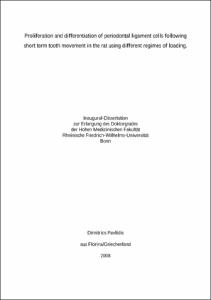Proliferation and differentiation of periodontal ligament cells following short term tooth movement in the rat using different regimes of loading


| dc.contributor.advisor | Jäger, Andreas | |
| dc.contributor.author | Pavlidis, Dimitrios | |
| dc.date.accessioned | 2020-04-13T01:14:27Z | |
| dc.date.available | 2020-04-13T01:14:27Z | |
| dc.date.issued | 2008 | |
| dc.identifier.uri | https://hdl.handle.net/20.500.11811/3808 | |
| dc.description.abstract | Previous studies have indicated that periodontal ligament cells demonstrate osteogenic potential and osteoblastic differentiation via the ERK pathway under mechanical stress in vitro and in vivo. This study aimed to further analyse this regulatory process experimentally in the rat. | |
| dc.language.iso | eng | |
| dc.rights | In Copyright | |
| dc.rights.uri | http://rightsstatements.org/vocab/InC/1.0/ | |
| dc.subject.ddc | 610 Medizin, Gesundheit | |
| dc.title | Proliferation and differentiation of periodontal ligament cells following short term tooth movement in the rat using different regimes of loading | |
| dc.type | Dissertation oder Habilitation | |
| dc.publisher.name | Universitäts- und Landesbibliothek Bonn | |
| dc.publisher.location | Bonn | |
| dc.rights.accessRights | openAccess | |
| dc.identifier.urn | https://nbn-resolving.org/urn:nbn:de:hbz:5M-15892 | |
| ulbbn.pubtype | Erstveröffentlichung | |
| ulbbnediss.affiliation.name | Rheinische Friedrich-Wilhelms-Universität Bonn | |
| ulbbnediss.affiliation.location | Bonn | |
| ulbbnediss.thesis.level | Dissertation | |
| ulbbnediss.dissID | 1589 | |
| ulbbnediss.date.accepted | 27.10.2008 | |
| ulbbnediss.fakultaet | Medizinische Fakultät | |
| dc.contributor.coReferee | Deschner, James |
Dateien zu dieser Ressource
Das Dokument erscheint in:
-
E-Dissertationen (1605)




